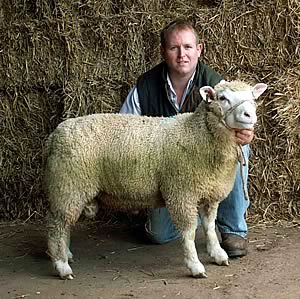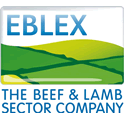| 2009-06-04
Pedigree sheep producer George Fell, who farms at Thorganby near York, has won the EBLEX Most Progressive Flock Award for the Meatlinc breed. The results are based on Signet records for 2008.
George Fell with one of his pedigree Meatlinc rams
 |
Organised through the Sheep Better Returns Programme, this is presented to the performance recorded flock that has shown the most impressive improvement in genetic merit, over a twelve month period, within the breed.
The Meatlinc breed was established by Mr Fell’s grandfather in the 1960’s while farming in Lincolnshire, drawing on the genetics of five different breeds. The aim was to develop a commercial ram that was able to service 60 to 80 ewes per season, and work for four to five years without needing a lot of concentrate feed or pampering.
Mr Fell is one of five franchised breeders in the UK. At an annual selection meeting, each breeder offers their best shearling rams for use by the other breeders. Mr Fell keeps 12 of his own ram lambs to try out on 25 ewes each, of which three or four remain to work on as shearlings. Two sire reference rams are selected from the other breeders every year to introduce new genetics into the flock.
The ewes are flushed before the rams join them at the end of October. The ewes stay out until Christmas, are shorn in the first week of January and then housed. They are fed a simple haylage diet until they lamb in April. Ewes bearing twins are fed concentrate four weeks before lambing; those with a single for two weeks before.
All lambs are weighed at eight weeks of age, weaned at 12 weeks and carried through the 21-week scan. They are reared off grass alone – and only given additional feed if grazing runs short.
When selecting the 12 ram lambs Mr Fell uses tools such as Estimated Breeding Values (EBVs) to help decide which ones to keep.
“We are looking for fast growth rate as this allows their progeny to hit target carcase specification at the right time. Muscle depth is also very important,” says Mr Fell. “Rams must also be sound and have decent length – as longer sheep weigh more!”
“Eighteen years ago we started the scheme with an index of zero - our figures now show how much we have improved since then. One of our top rams has a Scan Weight EBV of +13.23kg. This means he has the genetic capability of weighing 13.23kg more at 21 weeks than the average when we started. As he passes half of his genetics onto his offspring, this means he can pass half of this improved growth potential to each lamb he sires.
Another ram has a Muscle Depth EBV of +6.25mm, which highlights the progress made in lean muscle yield.
Ideally we are looking to combine high scores for both traits in one animal. We do have one with a +12kg score for scan weight and +6.19mm for muscle depth, so we are definitely going in the right direction.”
Around hundred of the best shearling rams are marketed off the farm from June, with 50% sold, mainly to commercial sheep farmers, by the end of July.
“Our customers tend to be producers who are looking for an alternative to the traditional terminal sire breeds,” Mr Fell explains. “Most are selling deadweight, so carcase characteristics such as killing out percentage and muscle depth are crucial. The breed is also easy-care, so we have a lot of buyers who are lambing outdoors or managing large flocks single-handedly.”
Commercial benefits
Alistair Freeland-Cook runs 1200 commercial Mules on a low input, easy care system on his upland farm in Northumberland, and buys three or four Meatlinc rams a year. He now places his order over the phone, trusting Mr Fell to select the most appropriate animals for his system.
He believes strongly that rams must have proven figures behind them, and that it makes no sense to buy on looks and then hope they produce the kind of lamb required.
“Our ewes lamb outdoors in April and the Meatlinc lambs hit the ground running
and never stop,” says Mr Freeland-Cook. “Almost all of them finish off grass and clover, and the Meatlinc genetics help them do this.
“We lamb from 1 April and start selling the singles ten weeks later. One third are sold before weaning – the rest are finished by the end of September, at a consistent 19-20kg deadweight. They all grade out at either R 3L or U 3L.”
Another of Mr Fell’s long term customers, Trevor Border has purchased Meatlinc rams to serve his 1800 Lleyns and Lleyn crossbreds for the past five years. Farming organically, it is important that the lambs finish off grass without having to resort to feeding expensive concentrates.
“I really believe in this breed and appreciate the hard work George puts into producing the best possible rams for our type of farming up here in the Rutland Hills,” says Mr Border. “The fact they are all performance recorded is also very reassuring.”
EBVs hold the key to progress
“Selecting and using rams with known, superior EBVs for key traits and a high overall terminal sire index, allows pedigree producers to advance their genetic base over a relatively short period of time,” says EBLEX sheep breeding specialist Samuel Boon.
“I congratulate George for the valuable work he, and the other Meatlinc breeders are doing with this breed. By focussing on, and recording production traits that really matter, they are not only improving their own flocks, but also making it easier for commercial customers to find rams they know will have a positive impact on their enterprise.”
 Winholme Bleu du Maine Flock is Most Progressive Winholme Bleu du Maine Flock is Most Progressive
 Millfields Hampshire Down Flock Awarded Championship Millfields Hampshire Down Flock Awarded Championship
 UK Mule - Promoting the Extraordinary UK Mule - Promoting the Extraordinary
|



